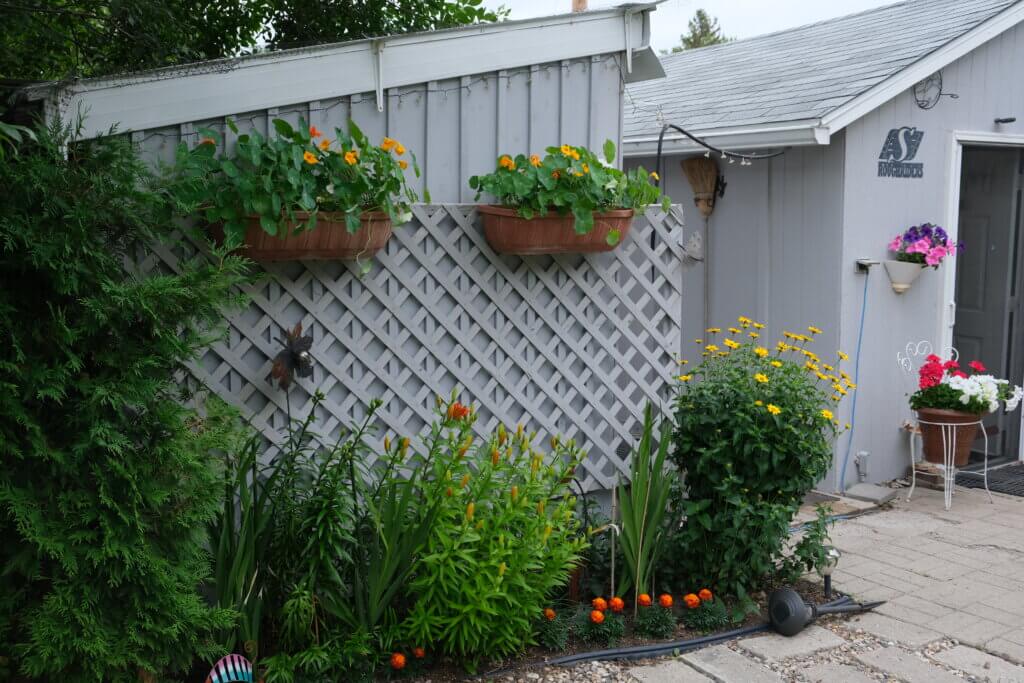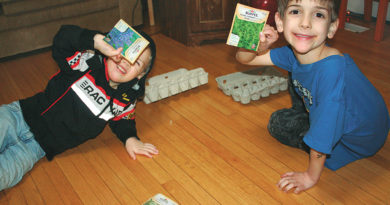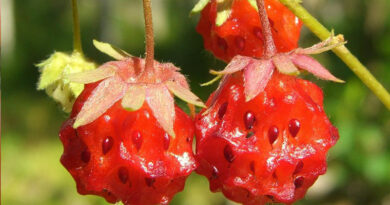Ken Macdonald’s vertical tomato garden in Regina
By Dorothy Dobbie
Ken Macdonald’s garden in Regina isn’t the acreage he imagined managing when he went to agriculture college in the Maritimes, but it has many redeeming qualities. Most notably, it has space for what he loves to grow: heritage tomatoes. As a busy realtor, he turns to his garden as his “happy place,” a sentiment spelled out on a sign mounted on his garden shed.
Growing tomatoes vertically in raised beds
Thanks to an ingenious vertical tomato garden system, Ken makes the most of his raised beds. His method is one seasoned growers will recognize, though it’s rarely seen in the average backyard.
Using a permanent wooden frame—six feet tall and four feet wide—crossed by three bars above a raised box, Ken supports his indeterminate tomato plants with string. These tomatoes grow vigorously until frost, often into late October. Each spring, he attaches strings from the upper bars to just above the soil and clips his tomato plants to the supports as they grow, adding hook-shaped attachments to keep fruit from breaking stems under their weight.
This vertical tomato gardening method keeps fruit clean and well-lit, while the raised beds improve drainage and allow consistent watering. Ken uses a half-strength 15-30-15 NPK fertilizer with a pump and siphon system, supplemented by Epsom salts, calcium, and bone meal. Still, he advises, “You don’t want to be too kind to them.”
Raised garden beds for vegetables and prairie weather protection
Ken’s soil is classic prairie gumbo, so he grows everything in raised beds—romaine lettuce, spinach, green and yellow beans, carrots, onions, and beets (mostly for the tops). He shields his crops from unpredictable prairie weather with frost blankets and heavy mover’s blankets to buffer against late frosts, spring snow, and summer hail.
A passion for prairie-bred heritage tomatoes
Ken is particularly devoted to heritage tomato varieties, carefully tracking their origins. “I have ‘Manitoba’ (named for the University of Manitoba), ‘Oxheart’ from 1925, ‘Scotia’ from Nova Scotia’s Kentville Experimental Farm, and ‘Quebec 2473’,” he says. He favours these varieties for their exceptional flavour, even though they may be less disease-resistant and have shorter shelf lives. He sources seeds from West Coast Seeds and Prairie Garden Seeds in Humboldt, Saskatchewan.
One year, Ken started 300 plants for the Regina Horticulture Association’s annual sale. His dedication earned him a lifetime membership.
More than tomatoes: Herbs, fruit, and pollinator-friendly plants
Ken grows cherry tomatoes in pots near trellises to let them bush freely. Close to the kitchen, planters overflow with herbs, marigolds, and strawberries. A second garden space near the alley houses more raised beds, including one that supports a raspberry bush (which Ken jokes is like one you’d find in a manure pile on the farm), a squash plant, daylilies, and rhubarb. The raspberry attracts birds and wasps—he nets for the birds but tolerates the wasps, hoping they pollinate and help with pest control.
He enriches his garden soil with compost from a hidden bin filled with rich black humus.
Flowers, memories, and a place to relax
Though primarily a food garden, Ken makes room for ornamental plants like milkweed for monarchs, mock sunflowers, potentilla, nasturtiums, and daylilies to attract bees and flower flies. A raised pond surrounded by maritime-themed ornaments, including a lighthouse, reflects his East Coast roots.
Near the deck, two brightly painted Adirondack chairs offer a place to relax—though knowing Ken, he’s more likely to be inspecting the fruit on his beloved tomato vines.




